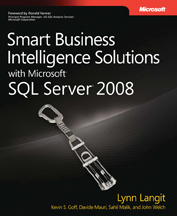New book: Smart Business Intelligence Solutions with Microsoft SQL Server 2008
Greetings, all. Here’s a new book that shipped to the printer in early January (online retailer availability date = February 4, although you can pre-order it now, and ISBN = 9780735625808): Smart Business Intelligence Solutions with Microsoft SQL Server 2008 , by Lynn Langit.

And here's Donald Farmer's Foreword, which includes a description of the book:
Foreword
When Lynn Langit’s name appears in my inbox or RSS feeds, I never know what to expect—
only that it will be interesting! She may be inviting me to share a technical webcast, passing
pithy comments about a conference speaker, or recalling the sight of swimming elephants
in Zambia, where Lynn tirelessly promotes information technology as a force for improving
health care. On this occasion, it was an invitation to write a foreword for this, her latest book,
Smart Business Intelligence Solutions with Microsoft SQL Server 2008. As so often, when Lynn
asks, the only possible response is, “Of course—I’d be happy to!”
When it comes to business intelligence, Lynn is a compulsive communicator. As a Developer
Evangelist at Microsoft, this is part of her job, but Lynn’s enthusiasm for the technologies and
their implications goes way beyond that. Her commitment is clear in her presentations and
webcasts, in her personal engagements with customers across continents, and in her writing.
Thinking of this, I am more than pleased to see this new book, especially to see that it tackles
the SQL Server business intelligence (BI) technologies in their broad scope.
Business intelligence is never about one technology solving one problem. In fact, a good BI
solution can address many problems at many levels—tactical, strategic, and even operational.
Part I, “Business Intelligence for Business Decision Makers and Architects,” explores these
business scenarios.
To solve these problems, you will find that your raw data is rarely sufficient. The BI developer
must apply business logic to enrich the data with analytical insights for business users.
Without this additional business logic, your system may only tell the users what they already
know. Part II, “Microsoft SQL Server 2008 Analysis Services for Developers,” takes a deep look
at using Analysis Services to create OLAP cubes and data mining models.
By their nature, these problems often require you to integrate data from across your business.
SQL Server 2008 Integration Services is the platform for this work, and in Part III,
“Microsoft SQL Server 2008 Integration Services for Developers,” Lynn tackles this technology.
She not only covers the details of building single workloads, but also sets this work in its
important architectural context, covering management and deployment of the integration
solutions.
Finally, in Part IV, “Microsoft SQL Server Reporting Services and Other Client Interfaces for
Business Intelligence,” there is a detailed exploration of the options for designing and publishing
reports. This section also covers other popular “clients”—the applications through
which business users interact with your BI solution. So, even if you are a Microsoft Office
Excel user, there is valuable information here.
When all of these elements—integration, analysis, and reporting—come together, you know
you are implementing a “smart solution,” the essence of this most helpful book.
I know from my own work at Microsoft, presenting and writing about BI, how difficult it is to
find good symmetry between technology and the business case. I also know how important
it is. Architects may build smart technology solutions, but enterprise decision makers put the
business into BI. For these readers, Lynn makes very few assumptions. She quickly, yet quite
thoroughly, takes the reader through a basic taxonomy of the moving parts of a BI solution.
However, this book is more than a basic introduction—it gets down to the details you
need to build effective solutions. Even experienced users will find useful insights and information
here. For example, all OLAP developers work with Analysis Services data source
views. However, many of them do not even know about the useful data preview feature. In
Chapter 7, “Designing OLAP Cubes Using BIDS,” Lynn not only describes the feature, but also
includes a good example of its use for simple validation and profiling. It is, for me, a good
measure of a book that it finds new things to say even about the most familiar features.
For scenarios that may be less familiar to you, such as data mining, Lynn carefully sets out the
business cases, the practical steps to take, and the traps to avoid. Having spent many hours
teaching and evangelizing about data mining myself, I really admire how Lynn navigates
through the subject. In one chapter, she starts from the highest level (“Why would I use data
mining?”) to the most detailed (“What is the CLUSTERING_METHOD parameter for?”), retaining
a pleasant and easy logical flow.
It is a privilege to work at Microsoft with Lynn. She clearly loves working with her customers
and the community. This book captures much of her enthusiasm and knowledge in print. You
will enjoy it, and I will not be surprised if you keep it close at hand on your desk whenever
you work with SQL Server 2008.
Donald Farmer
Principal Program Manager, US-SQL Analysis Services
Microsoft Corporation
This is Lynn’s blog: https://blogs.msdn.com/socaldevgal/default.aspx. And here’s Donald’s: https://www.beyeblogs.com/donaldfarmer/.
More on other new books soon!